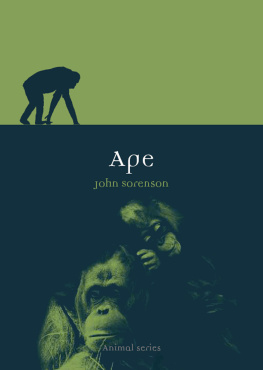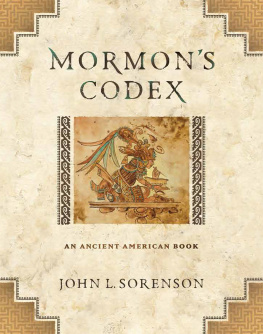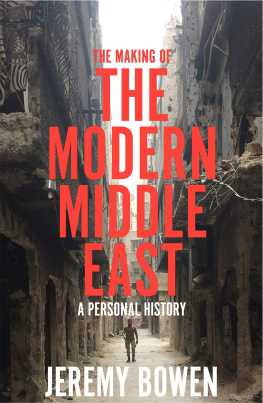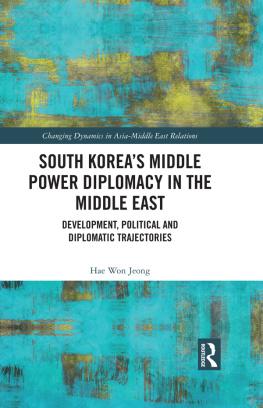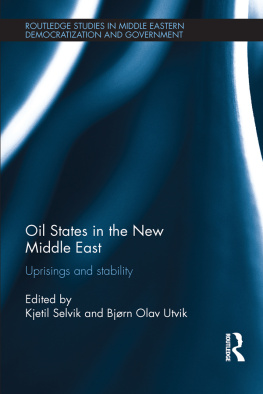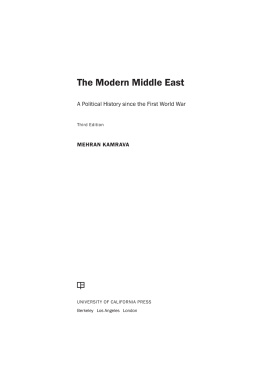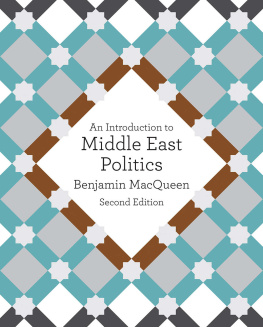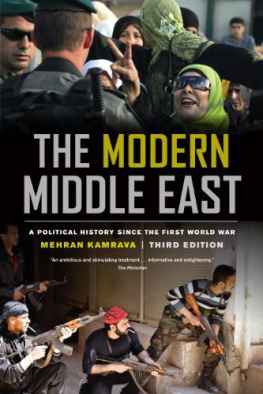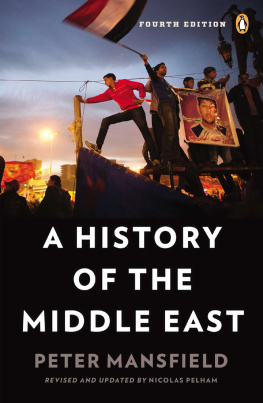An Introduction to
the Modern Middle East

WESTVIEW PRESS was founded in 1975 in Boulder, Colorado, by notable publisher and intellectual Fred Praeger. Westview Press continues to publish scholarly titles and high-quality undergraduate- and graduate-level textbooks in core social science disciplines. With books developed, written, and edited with the needs of serious nonfiction readers, professors, and students in mind, Westview Press honors its long history of publishing books that matter.
Copyright 2014 by Westview Press
Published by Westview Press,
A Member of the Perseus Books Group
All rights reserved. No part of this book may be reproduced in any manner whatsoever without written permission except in the case of brief quotations embodied in critical articles and reviews. For information, address Westview Press, 2465 Central Avenue, Boulder, CO 80301.
Find us on the World Wide Web at www.westviewpress.com.
Every effort has been made to secure required permissions for all text, images, maps, and other art reprinted in this volume.
All photographs were taken by the author. The maps are from the CIA and in the public domain.
Westview Press books are available at special discounts for bulk purchases in the United States by corporations, institutions, and other organizations. For more information, please contact the Special Markets Department at the Perseus Books Group, 2300 Chestnut Street, Suite 200, Philadelphia, PA 19103, or call (800) 810-4145, ext. 5000, or e-mail .
DESIGNED BY JEFF WILLIAMS
A CIP catalog record for the print version of this book is available from the Library of Congress.
ISBN: 978-0-8133-4923-7 (e-book)
10 9 8 7 6 5 4 3 2 1
CONTENTS








When I sent the first edition of this text to Westview in late 2007, I frankly believed that it would remain current for at least five years. I thought that while leaders, economies, and security situations would change, the Middle East would remain largely dominated by autocratic regimes. When this book first appeared in 2008, Freedom House, an international barometer of political accountability, ranked seven Arab countries as partly free (Jordan, Yemen, Bahrain, Morocco, the Palestinian-Administered Palestinian territory, Kuwait, and Lebanon). By 2010, the number of partly free Arab countries dropped to three, as the Palestinian Territories, Jordan, Yemen, and Bahrain increased state power to clamp down on either anti-regime protestors or terrorists, though it was sometimes difficult to distinguish between protestors and terrorists as some regimes dub all their opponents as terrorists. To reverse-engineer former President George W. Bushs comment that democracy is on the march in the Middle East, it was marching backwards. And this occurred before the Arab Spring had really begun. To be sure, some of the signs of popular unrest were there: not only increased expressions for regime support of, or indifference to, an assertive American role following September 11, in Iraq in particular, but also the almost nonexistent peace efforts that had been initially so promising after the first Gulf War of 19901991. A growing community of bloggers took advantage of regime unfamiliarity with the communications revolution that increasingly disabled regime-generated messages calling for support of the status quo.
Yet the few warning signs that things were about to change in both Iran and the Arab countries were easy to ignore. When Egypts Mubarak stood for reelection in 2009, in what was supposed to be Egypts first competitive presidential election, a wide swath of the Egyptian public viewed the elections as rigged. Yet there was little noticeable opposition, even when security forces arrested the runner-up candidate and sent him to jail. Across the Sinai, Palestinian rivals clashed over control of the small territory that Palestinians actually controlled, and much of Lebanon remained in tatters after the 2006 war between Hezbollah and Israel damaged much of the reconstruction efforts from the civil war that ended in 1989. A broad cross-section of Iranians did take to the streets in an effort to change the regime after a strongly disputed presidential win by Mahmoud Ahmadinejad over his nearest rival, Mir Hossein Mousavi. The security forces loyal to Ahmadinejad and the Supreme Leader, Ali Khamenei, suppressed the movement violently, and its end appeared to resemble other popular movements against Arab rulers: brief and massive street demonstrations, work stoppages, expressions of outrage, and then rapid suppression by security forces, followed by a quiet if angry resignation. In 2009, there was no expectation that the next year would usher in the so-called Arab Spring.
So in late 2010, when a young vegetable seller in Tunisia immolated himself in protest over humiliation by the corrupt police, it appeared to be just another act of protest, albeit tragic, but when President Zine Abidine Ben Ali departed the country only days after protests spread from the countryside to Tunis, many Arab countries suddenly burst into energetic demonstrations against long-entrenched rulers. The familiar slogan Islam is the answer became Tunisia is the answer in Cairo as demonstrators camped in that citys Tahrir Square, the site of many previous failed efforts to change Egypt. International as well as regional journalists rushed to Cairo to cover these surprising events, as largely young and leaderless crowds seemed to swell in both size and enthusiasm daily. From Cairo, demonstrations spread to Muscat, Amman, Rabat, Manama, Tripoli, and other Arab capitals, sometimes met peacefully by security forces, sometimes by clouds of tear gas. Observers could be forgiven for assuming that most of these anti-regime movements would end up as they did in Iran, defeated by security forces willing to use considerable violence to protect the regimes that they served. Yet after around two weeks of protracted rallies, President Mubarak boarded a plane for his retreat in Sharm al-Shaykh, and a self-appointed military commission, the Supreme Military Commission, stepped in to administer Egypt. As the actions continued, other Arab autocrats joined Mubarak in exiting their countries, though in dramatically different manners. Yemens long-serving President Ali Abdullah Saleh left his country for medical care abroad after a hidden bomb badly burned him as he was praying, and Libyas Muammar Qadhafi died violently at the hands of a mob that captured him after NATO aircraft disrupted a convoy attempting to carry Qadhafi and some supporters to safety.
Next page

